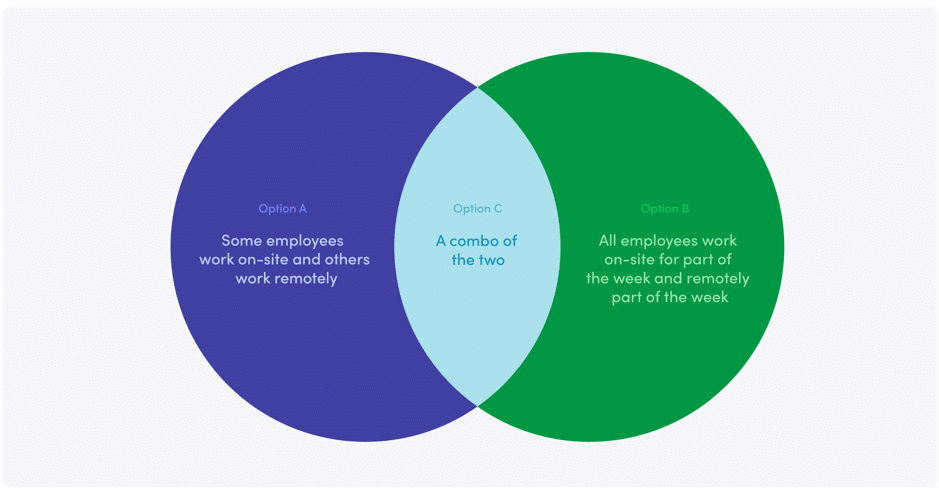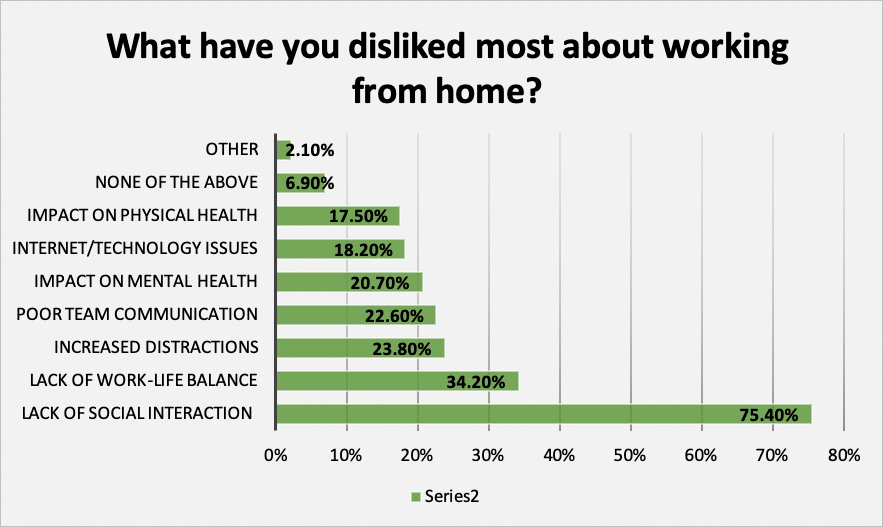The Unknown
It’s the end of 2021, the world upside down, Covid as a heavy cloud still constrains humanity. Uncertainty teasing us every day. When is life going to get back to normal? Or is the worst yet to come? We don’t have those answers, but what we do know, is that the world has significantly changed and humankind continues to adapt to the new circumstances.
The new trend
Lockdowns across the world made millions of people suddenly working from home — and guess what? It turns out that most people can do their jobs just as well from their comfortable homes. A survey over 4,000 UK office workers run by Microsoft and YouGov, found that more than half of the workers (56%) felt happier when they were able to work from home. In the same survey half (51%) of UK workers, who currently have the option to mix remote and office working, would consider leaving their company if this hybrid option was removed[1].
In a recent survey from HubbleHQ in which 1,000 employees, living in the UK and typically working from the office, were asked the question how they have found working from home. Most people (70%) have had a positive experience working from home, whereas only 7% stated that they had a negative experience. The survey also shows that 76% of respondents said that they feel as productive, if not more productive working from home[2].
A survey from Slack conducted between June and August 2020 on global knowledge workers[3]confirms that a migration back to the office fulltime is not desirable, with only 12% saying they would like to always work at the office and over half of all knowledge workers (72%) expressing a preference for a hybrid remote-office model. The key reason for that is the Flexibility that comes with the hybrid work model according to the survey. It’s simply easier to find balance in a flexible work arrangement. This way people can organize their time better, and use that time to take care of personal matters. A hybrid remote-office model is a plan, where companies allow employees to work partly in-office and partly remote. There is no one size fits all solution. Every company finds its best hybrid model to fit with their needs and those from the employees. See figure 1 below[4].

Figure 1: This figure is showing the different kind of hybrid models
The message is clear, ano 2020/21 people adapted to a new way of work and the majority have no desire to move fulltime back to office. The question shouldn’t be when workers will return to the office, but companies should rather be asking the question what the office of the future will look like. The desire to work from home or different places and the feeling of trust between bosses and their workers is the key to future work.
How does the office of the future look like?
A question we cannot answer yet. But what if we asked people how they would like to work in the future? In the same survey from HubbleHQ that we mentioned before, they asked exactly this question and here are the answers. People are keen to work significantly more remotely in the future than they did in the past. In fact, a big 86% want to work somewhere other than the office for at least once a week—although only 15% want to do so every day. When not in the office, most people would like to work from home (79%), a coworking space (that is not their main office) (42%), abroad (42%), or from a cafe (31%).
The negative side effect of working from home
Working remotely also brings negative side effects. Once again, we have a look the survey from HubbleHQ where they asked the same group about the negative aspects of working from home[5]. See the result in figure 2 below:

Figure 2: This graph is showing things employees disliked about working from home.Displayed in percentages
The lack of social interaction has with 75,4% the highest impact on the negative aspect about working from home. Followed by the lack of work-life balance and increased distractions. Nevertheless, when we imagine people working remotely from a different location than home (work-from-anywhere WFA), where the Covid restrictions are less extreme, we would expect an increase of social interaction due to the fact, that there are more opportunities to do so. We would also expect the work life balance and the impact on mental health to naturally recover due to the positive environment people blend in with. Therefore, many of the negative aspects that we see in the graph above can be easily tackled by creating the opportunity for employees to work from abroad.
Why companies should consider to change their remote working policy to work from abroad
According to Harvard’s research remote employees, who can choose where to work from, are more productive than those who are restricted to one geographic location, while maintaining quality[6]. Another recent research from Harvard confirms that work-from-anywhere (WFA) policies enhance individual productivity, and moreover shrink workspace costs, reduces employee leave and expand the talent pool[7]. The latter applies because companies that allow employees to work abroad can choose the best talent worldwide. They are not anymore restricted to the local supply. This way of hiring gives teams a competitive edge and reducing the cost of recruitment.
We also see an increase in trust between employee and employer when the employer allows workers to work overseas, which increase the feeling of being valued and enhance the motivation of your workforce.
At last, maintaining a flexible policy for remote work abroad makes you, as a company, a very attractive player on the market. With competition lurking this could be a gamechanger in attracting new talent for your company.
Conclusion
It’s undeniable to say that the way we work has been significantly changed due to Covid and this will have a huge impact on employers and employees for future work. Due to new standard and opportunities, employees have other expectations and desires. A significant amount of employees would like to use their company’s remote working policy to work from abroad, whenever this is possible. Working abroad means, that your employees will be more happy, more productive and you will attract the best talent for your company. Therefore, we see work-from-anywhere (WFA) as a win-win situation for employee and employer.
Important though is, that you follow the rules and make sure your employers are setup correctly. Go Remotical helps you, the employer, to set up a work-from-anywhere policy and consults how to best include the remote work trend in your company to stay ahead of the market. We also set up the remote workspace for your employees and equip it to the company standards.
Read & share
If you interested in real life stories of people already working remotely, check out our interviews and our story blogs, where we give updates on recent events, typical days of Remoticals or other remote working topics.
Get in touch
Feel free to write us your story or experience of remote working at Facebook or Instagram. We are always keen to learn how other people handle their remote work.
[1] Microsoft in conjunction with YouGov, with fieldwork undertaken between October 7 and 15, 2021.
[2] https://hubblehq.com/should-we-ditch-the-office/survey-results#page-intro
[3] https://slack.com/blog/collaboration/workplace-transformation-in-the-wake-of-covid-1
[4] https://envoy.com/blog/what-is-a-hybrid-work-model/
[5] https://hubblehq.com/should-we-ditch-the-office/survey-results#page-intro
[6] https://hbr.org/2019/08/is-it-time-to-let-employees-work-from-anywhere
[7] https://hbr.org/2020/11/our-work-from-anywhere-future



